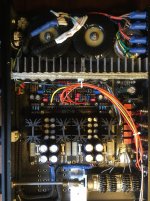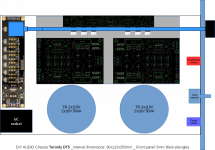I have been listening this preamp for a while now, and now I can say something about it.
Its by far the best sounding pre I have ever listened. Everything is balanced, bass is wide and well defined ( perhaps best bass I have ever heard), wide soundstage and very fast and accurate and airy.
I only listen vinyls, my turntable is diy mass loaded (60kg) with Graham 2.2 tonearm and Benz Lps cart, phono pre is Vendetta research scp2C, speakers are Genelec 1038 actives.
Thank you very, very much Salas.
This is my first ever build and it went pretty smoothly. Well, the case could be bigger, pretty tight fit now.
I have BC327 mirrors and some critical resistors are Vishay RCK02. I first used series stepped atteunator with Welvyn resistors, but it was a litle bit too tight on higher frquencies. I put my trusty ladder type pot with Holco H4 non magnetic resistors and now its as I want it to be.
View attachment 817273
Its by far the best sounding pre I have ever listened. Everything is balanced, bass is wide and well defined ( perhaps best bass I have ever heard), wide soundstage and very fast and accurate and airy.
I only listen vinyls, my turntable is diy mass loaded (60kg) with Graham 2.2 tonearm and Benz Lps cart, phono pre is Vendetta research scp2C, speakers are Genelec 1038 actives.
Thank you very, very much Salas.
This is my first ever build and it went pretty smoothly. Well, the case could be bigger, pretty tight fit now.
I have BC327 mirrors and some critical resistors are Vishay RCK02. I first used series stepped atteunator with Welvyn resistors, but it was a litle bit too tight on higher frquencies. I put my trusty ladder type pot with Holco H4 non magnetic resistors and now its as I want it to be.
View attachment 817273
Attachments
Good job. Congratulations. This preamp thrives on a good & well suited pot indeed. It does not have spots for expensive coupling capacitors because DC anyway so there is only one major place to spend for a better than average part, the pot. Some strategically placed Vishay Sfernice foil resistors you used did not hurt either. How many kΩ nominal is your ladder attenuator?
Regarding J1/J2. I surely missed the info.
How comes that they are absent in the final builds? Looks like they are not soldered (or do I need glasses?). Same in the pdf guide file.
How comes that they are absent in the final builds? Looks like they are not soldered (or do I need glasses?). Same in the pdf guide file.
You mean the J1/J2 round place? Its an alternative for a Linear Systems near type metal can package, but most people use the NEC NOS μPA in-line plastic package which is designated J1/J2 the same, located just below. Both are monolithic matched JFET doubles.
The pcb of the preamp is 160x50mm.
To those who soldered the parts, how high is it (solder+pcb+components)?
Trying to think of the floor plan with the signal lines as far as possible from the power lines (bk56er-like https://www.diyaudio.com/forums/att...salas-dcg3-preamp-line-headphone-img_1340-jpg); the pcb of the preamp would be vertical. Would it fit in a 40mm space?
To those who soldered the parts, how high is it (solder+pcb+components)?
Trying to think of the floor plan with the signal lines as far as possible from the power lines (bk56er-like https://www.diyaudio.com/forums/att...salas-dcg3-preamp-line-headphone-img_1340-jpg); the pcb of the preamp would be vertical. Would it fit in a 40mm space?
Last edited:
Salas, thanks for the reply, but was speaking of the preamp board only 😉
Looks like C6/C7 are the highest components of the preamp. According to the datasheet 100uF/50V Panasonic FC and Nichicon FG should have a body of 12.5mm.
So let's say less than 20mm high for the preamp itself, is that correct?
Edit: should have said DCG3 board instead of 'preamp' 😉
Looks like C6/C7 are the highest components of the preamp. According to the datasheet 100uF/50V Panasonic FC and Nichicon FG should have a body of 12.5mm.
So let's say less than 20mm high for the preamp itself, is that correct?
Edit: should have said DCG3 board instead of 'preamp' 😉
Depends on how the Mosfets will lay in your config. If horizontal then those caps are standing higher. Provided you will not use monster screw terminals. But if the Mosfets are standing vertically they will be the taller components. Leg length you allow included. Say 20mm from board level to tab's top or bit less. Then the board is around 2mm thick itself and you would want to mount it sturdy onto, but clear from, a panel. Standoff screws have a height too.
In point of fact the DCG3 board would be vertical with the mosfets in the bottom, with screws going through mosfets-flat heatsink; with larger holes in the bottom of the case in front of the mosfets in order to reach the screws.
Got a toroidy DT5 box when ordered the transformers, trying to fit DCG3+2DCSTB+iselect+2transformers in its 350x210x55mm.
Saw some pics with the audio components near the transformers/power lines, would like to avoid that, even if no noise/humm/etc. was reported (https://www.diyaudio.com/forums/attachments/analog-line-level/807257d1578341443-salas-dcg3-preamp-line-headphone-q1-jpg).
Will try to post a picture too 😉
Got a toroidy DT5 box when ordered the transformers, trying to fit DCG3+2DCSTB+iselect+2transformers in its 350x210x55mm.
Saw some pics with the audio components near the transformers/power lines, would like to avoid that, even if no noise/humm/etc. was reported (https://www.diyaudio.com/forums/attachments/analog-line-level/807257d1578341443-salas-dcg3-preamp-line-headphone-q1-jpg).
Will try to post a picture too 😉
Thanks. 7.5k ladder has output impedance like a 15k series. So your pot has near the usually recommended 20k series type's insertion impedance effect. All well.
In general DCG3 wants some care in the volume setting mechanism quality else it will highlight an opaque or harsh pot. Has no buffer for it, due to intended minimalism, so the pot is very much a part of the input stage.
In general DCG3 wants some care in the volume setting mechanism quality else it will highlight an opaque or harsh pot. Has no buffer for it, due to intended minimalism, so the pot is very much a part of the input stage.
Here is a pic, likely easier, the grey shape is the flat plate/heatsink:
I see the sketched volume extension rod going all the way to the back passing over the Mosfets.
See it not to block easy screwdriver access to their tab screws from above in the practical build.
What pot model are you planning to use by the way?
Yes, good point, in the sketch the extension rod is blocking the access to the screws for the mosfets. There will be some way to play around with the final positions. The best way would leave the access free, in the worst case the rod will have to be removed in order to access the screws. The DCSTB will also be symetrical, I copy/pasted the same one in the sketch loosing the symetry.
The pot will be the blue ALPS one, forgot about the value though, 10k or 20k.
Back to the rod, even if the final box is supposed to be in metal and grounded, it looks like an antenna. Wondering if some people are using something else than metal (hard plastic rod?).
The pot will be the blue ALPS one, forgot about the value though, 10k or 20k.
Back to the rod, even if the final box is supposed to be in metal and grounded, it looks like an antenna. Wondering if some people are using something else than metal (hard plastic rod?).
Avoid the Alps blue in this preamp if possible. Holds back its performance potential enough. Use a TKD 2CP-601 or 2CP-2511. If you can't find TKD as 20k Log, get it in 10k Log but use 5k6 R1 in the DCG3 instead of the 3k3 standard.
The extension rod if metal should be at ground potential along with the pot's metal part to the chassis. Sometimes there could be hum if not. Especially when touching a metallic volume knob. A wire to chassis from the pot's collar can be used. Chassis should be mains earthed.
The extension rod if metal should be at ground potential along with the pot's metal part to the chassis. Sometimes there could be hum if not. Especially when touching a metallic volume knob. A wire to chassis from the pot's collar can be used. Chassis should be mains earthed.
TKD 2CP-601 or 2CP-2511...
Thanks for the info. Looks like the 601 has pins like the blue one while the 2511 has pins that cannot be inserted directly in the i-select (pins to be wire soldered). In that case I would prefer the 601.
Got Tea-Bag's kit loooong ago, still all together in a box. Will check for TKD suppliers here in France.
Thanks for the info. Looks like the 601 has pins like the blue one while the 2511 has pins that cannot be inserted directly in the i-select (pins to be wire soldered). In that case I would prefer the 601.
Got Tea-Bag's kit loooong ago, still all together in a box. Will check for TKD suppliers here in France.
Best practice is to make a metal bracket for holding any type of pot placed next to the In-Select board. Or in front of it. It will both allow type experiments and automatically ground the metal bits to chassis. It will also hold the mechanism firmly without passing stressful forces to pins. The pot's pins can be wired with short runs to the board pads. Such brackets can be seen in many builds here.
By the way here's a relevant thread in our forum with pictures of the 601 internals:
Guts of a TKD potentiometer!
Those taps seen on its printed resistance element configure it like a half ladder pot. The cheap Ebay mini stepper also discussed there is surely cleaner and better focused than the Alps blue but little kind of harsh and shallow compared to a TKD or to a high priced stepper. Talking from personal experience. Its 21 steps are still rough for very nice volume setting. Especially if on sensitive speakers. When the TKD custom log curve is well gradual and of course continuous because it has a wiper. Using a mounting bracket would allow comparisons down to personal preference and system synergy in any case.
Guts of a TKD potentiometer!
Those taps seen on its printed resistance element configure it like a half ladder pot. The cheap Ebay mini stepper also discussed there is surely cleaner and better focused than the Alps blue but little kind of harsh and shallow compared to a TKD or to a high priced stepper. Talking from personal experience. Its 21 steps are still rough for very nice volume setting. Especially if on sensitive speakers. When the TKD custom log curve is well gradual and of course continuous because it has a wiper. Using a mounting bracket would allow comparisons down to personal preference and system synergy in any case.
- Home
- Source & Line
- Analog Line Level
- Salas DCG3 preamp (line & headphone)


